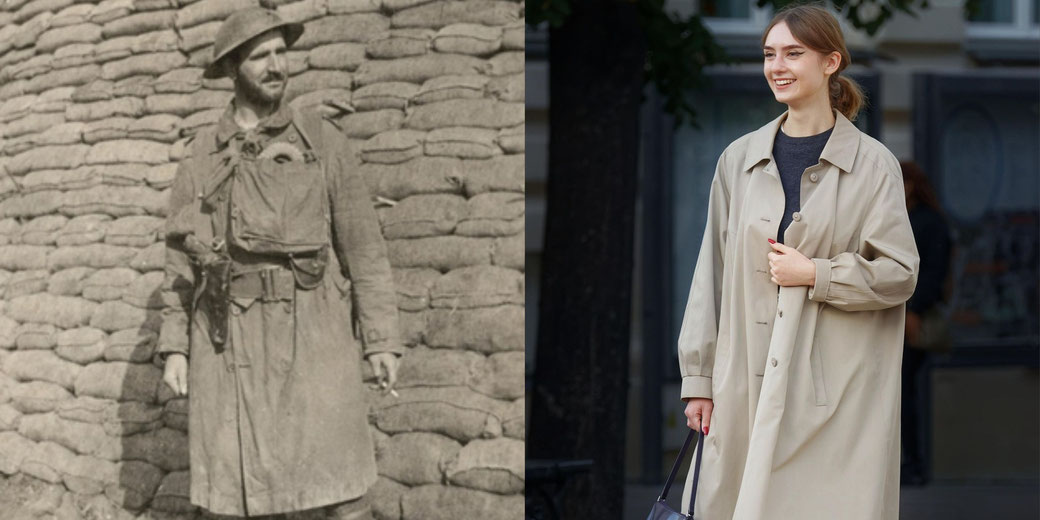From WWI battlefields to fashion icon: The remarkable history of the Trench Coat

The trench coat is one of the most popular winter garments in the world today. Endlessly adaptable and seen as an icon of many fashionable celebrities, almost everyone about them.
However, the trench coat has a history just as fascinating as its design. For many people who are unaware, they are often shocked to learn how it has evolved from a practical military necessity to a symbol of style and sophistication.
Why was the Trench Coat originally made?
The story of the trench coat began in the late 19th century. In 1879, Thomas Burberry, an English outfitter, invented gabardine, a waterproof, yet breathable fabric.
His innovation was groundbreaking, although he may not have known it at the time.
It was not until the outbreak of World War I that the garment would come into its own.
During the early years of the war, specifically around 1914, the British military recognized the need for an overcoat that was both functional and suitable for the new style of warfare being waged in the trenches.
At the time, traditional heavy woolen coats proved impractical in the muddy, wet conditions of the western front.
In contrast, the trench coat, made of the newly invented gabardine, was promoted as an effective solution.
Unlike the older coast, it was lightweight, weather-resistant, and allowed for ease of movement: all of the characteristics the military was seeking.

In particular, the coat was equipped with a number of features that were well-suited for the rigors of trench life.
D-rings were added to hang equipment, epaulettes were used to display rank, and large pockets were designed for carrying maps and other essentials.
The original design also included a storm flap to prevent rainwater from seeping in and a belt with a buckle for adjusting the fit.
As World War I progressed, the trench coat eventually became a standard issue for officers in the British and French armies.
At the war's end in 1918, these officers returned home, bringing their trench coats with them.
The coat's functional design and association with the heroism of wartime service appealed to the civilian population.
It soon began to make an impact on the fashion world as a result.
How it became associated with spies and detectives
Following its military origins during World War I, the trench coat began to be purchased by civilians in the 1920s.
Initially, it retained many of its original military features, such as the D-rings and large belt.
However, as it transitioned into a fashion item, these elements gradually became more decorative than functional.
The 1920s and 1930s saw the trench coat adopted by both men and women, with the garment becoming shorter and more fitted for women.
The real turning point in the trench coat's evolution came in the 1940s and 1950s: particularly in the post-World War II era.
This period witnessed the trench coat's increasing presence in Hollywood cinema.
It was worn by film noir detectives and romantic leads alike. However, the fabric began to vary, with lighter materials for spring and heavier ones for winter.
The bright colours and sophistication of the 1960s
Then, in the 1960s and 1970s, the trench coat embraced more dramatic changes in line with the fashion trends of these decades.
It was during this time that the coat was created in a variety of colors, lengths, and patterns.
For the first time, it moved away from the traditional khaki, even embracing bold prints and brighter hues.
Also, this era also saw designers experimenting with bold new materials, such as leather and vinyl.
The late 20th century and the early 21st century then saw the trench coat become a staple in both high fashion and everyday wear.
Major fashion houses have reinterpreted the coat in numerous ways, playing with its cut, color, and fabric, while retaining its classic elements like the double-breasted front, wide lapels, and belt.
Finally, the 2000s onwards have also witnessed a focus on sustainability and technology in fashion, leading to the use of eco-friendly materials and advanced fabrics.
It also enhanced the trench coat's functionality, developing new the features of water-resistant and breathable fibers.

Why the Trench Coat remains popular 100 years later
In contemporary fashion, the trench coat has moved well beyond its utilitarian roots to become a versatile and enduring symbol of style.
Today, the trench coat is celebrated for its elegant simplicity and practicality, while it adaptability makes it suitable for various occasions: from formal events to casual outings.
What do you need help with?
Download ready-to-use digital learning resources
Copyright © History Skills 2014-2025.
Contact via email
With the exception of links to external sites, some historical sources and extracts from specific publications, all content on this website is copyrighted by History Skills. This content may not be copied, republished or redistributed without written permission from the website creator. Please use the Contact page to obtain relevant permission.





